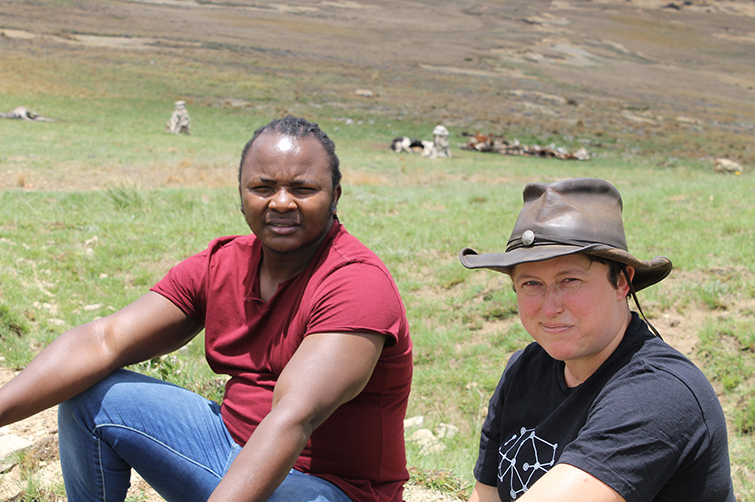03 January 2020
|
Story Leonie Bolleurs
|
Photo Leonie Bolleurs
 Prof Aliza le Roux and Dr Mpho Ramoejane at the vulture restaurant, nearly 30 km from Clarens. This is a safe space for vultures to feed, in an effort to increase their declining numbers.
Prof Aliza le Roux and Dr Mpho Ramoejane at the vulture restaurant, nearly 30 km from Clarens. This is a safe space for vultures to feed, in an effort to increase their declining numbers.
Endangered bird species such as the
Cape and
bearded vultures attract bird enthusiasts from afar. These birds are close to extinction in Southern Africa and classified as near threatened on the
International Union for Conservation Nature (IUCN) list, with a strong global decline in their numbers.
A viewing hide constructed by honorary rangers in the Golden Gate Highlands National Park, about 30 km from Clarens in the Eastern Free State, offers tourists the opportunity to view and photograph the birds as they feed at one of South Africa’s close to 200 vulture restaurants.
This tourist attraction is situated in a good location from a conservation perspective, with vulture colonies and – importantly – water close by, according to
Prof Aliza le Roux.
Prof Le Roux, Associate Professor in the
Department of Zoology and Entomology on the Qwaqwa Campus of the University of the Free State (UFS) and affiliated to the
Afromontane Research Unit (ARU), is working with one of her students, Agnes Mkotywa, on a study regarding the effectiveness of this feeding site.
Poisoned carcasses big threat to vultures
She said there are quite a few vulture restaurants in the area, with the most famous one at Giants Castle.
A vulture restaurant is an area where park rangers drop non-poisoned carcasses, mostly donated by nearby farmers. Poisoned carcasses, bait for other animals such as jackals and caracals, are one of the biggest threats to vultures.
The vulture restaurants, an effort to get vulture populations to grow, are within the reach of Cape and bearded vultures. But, as found in Mkotywa’s study, the initiative has its shortcomings.
Prof Le Roux said the current structures are open, and black-backed jackals come to feed any time of the day and night. “There is more feeding of the jackals than the intended vultures, and the current structure does not protect the vultures against the jackals,” she said. Jackal activity at the vulture restaurant is significantly higher than elsewhere in the park, as supported by camera traps set up in the park by Dr Mpho Ramoejane, currently an ARU postdoctoral researcher.
Raised platform a possible solution
“This is one of our primary research findings. A possible solution is to put up fences. It will, however, keep everything else out and will be an eyesore from a tourist perspective. A raised platform that could exclude the jackals and still provide the vultures with a large landing place, might work,” Prof Le Roux added.
Another finding was that carcasses are not dropped regularly enough. Vultures cannot predict when there will be food.
These findings will be published in peer-reviewed outlets, but it will also be communicated to the management of the South African National Parks (SANParks) to address the problem. “SANParks is involved in the project and wants the information. They said they needed the information and will build on it,” said Prof Le Roux.
Once the suggested changes are implemented, she is excited to scientifically document how these changes are making a difference. This has the potential to guide the management and development of vulture restaurants elsewhere in South Africa and the world.